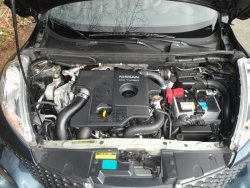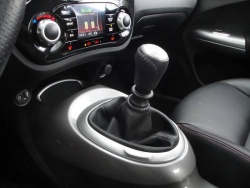Review and photos by Greg Wilson
Photo Gallery:
2011 Nissan Juke
We recently tested a Nissan Juke SL AWD with Nissan’s new “torque-vectoring” all-wheel drive system that transfers power both front to rear and side to side at the rear wheels for improved traction and handling – a similar system to Acura’s Super Handling All-wheel Drive. This is an excellent safety feature for driving on wet, icy or snowy roads, and hopefully, this technology will migrate to other Nissan vehicles as well.
Unfortunately, the Juke’s AWD system is available only when matched to a continuously variable transmission – the standard six-speed manual transmission comes only with front-wheel drive.
Still, you can save about three thousand dollars by choosing the Juke front-driver with a manual gearbox, and it’s arguably more fun to drive with a manual transmission; plus it’s about 118 kg (258 lbs) lighter, weighing in at 1323 kg (2917 lbs). Another benefit to choosing the front-wheel drive Juke is the addition of a large, removeable plastic storage bin under the cargo floor made possible by the absence of a rear differential. It’s a great place for keeping cold drinks, groceries or valuables you want to keep out of sight.
Another difference between the front-wheel drive Juke and the all-wheel drive model is the type of rear suspension: the FWD model has a semi-independent torsion beam setup while AWD models offer an independent multi-link suspension. Having driven both (at different times) I don’t recall any major handling differences, but in theory the AWD model is better equipped to handle uneven road surfaces and provide a better ride. Still, torsion-beam rear suspensions, like that used in the Golf for many years, are proven to offer good handling and ride qualities in small cars.
Driving impressions
  2011 Nissan Juke SL FWD. Click image to enlarge |
The FWD Juke’s standard six-speed manual transmission has a meaty, shift knob that pokes out from what looks like a motorcycle fuel tank in the centre console. It’s easy to reach and easy to shift, and clutch engagement is generally smooth. However, the clutch is a bit sensitive when engaging First gear unless you give it some revs, and the first gear ratio is a bit too low, with the result that you need to rev it high before you move into second gear; shifting from second through sixth gears is a more progressive transition. At a steady 100 km/h in sixth gear, the engine turns over a quiet 2,600 rpm.
The Juke’s engine is a relatively small 1.6-litre DOHC 16-valve four-cylinder, but with the use of direct fuel injection, variable valve timing, and a turbocharger/intercooler, horsepower is a healthy 188 at 5,600 rpm and maximum torque is 177 pound-feet from just 2,000 rpm up to 5,250 rpm. Accelerating from a standing start, the engine feels a bit weak until about 2,000 rpm (turbo lag), but then it takes off with a surge of power that pushes the Juke from zero to 100 km/h in 8.0 seconds, according to AJAC. However, AJAC tested a Juke AWD with a CVT, and I suspect the lighter, front-wheel drive Juke with a manual transmission would be a least a half second quicker.
Juke SL models, both FWD and AWD, are equipped with a driver-selectable electronic performance adjuster called Integrated Control (I-CON) that gives the driver a choice of three different throttle and steering response settings, Normal, Sport and Eco. In the CVT-equipped Juke, Sport mode also includes simulated gearshifts and the ability to shift manually using the shift lever.
As you might suspect, Eco mode retards the throttle for slower acceleration and easier steering. Normal mode improves throttle response, while Sport mode offers a more aggressive throttle and steering feel. The one you choose will depend on whether you want to maximize fuel economy or enhance performance, but every time you start the Juke it defaults to Normal mode. Personally, I enjoyed the extra performance of Sport mode.











